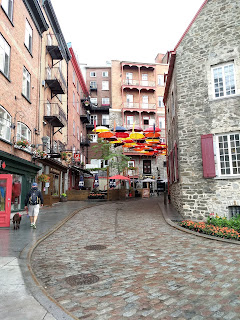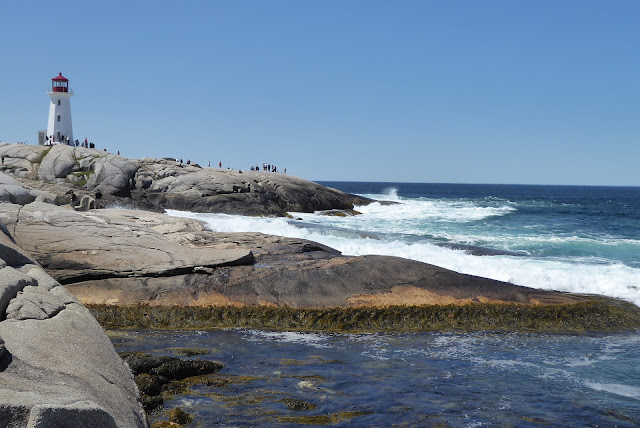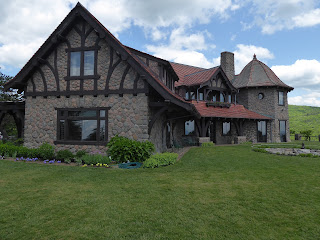July 2018 – Eastern Canada
 |
| Kayeanne took this one. Crystal Beach wan't all bad |
Ten campgrounds in five provinces in one month made July
pretty hectic, and it didn’t start out very auspiciously. I had a bad feeling
when we were directed to back into a pull through site on grass at Crystal
Beach. A lot of rain had fallen in June and the campground management was
clearly worried that the ground might be too soft for our heavy coach. I should
have listened to my gut, because after sitting for four days we had to dig
trenches in front of the wheels and fill them with gravel to finally claw our
way out of that campsite. Charlie’s lighter coach pulled right out, but not
ours. Unfortunately we were so focused on getting out that we didn’t take any
pictures, but I had blisters for a couple of weeks. I am not planning a return
visit to Crystal Beach.
 |
| Friends |
Right next door was Bishops
Machine Shop Museum. “Machine
Shop Museum
We moved to Northumberland
Provincial Park on the southeast side of the island to see Charlottetown PEI to Nova
Scotia
Charlie and Mollie suggested a road trip to North Lake
East
Point Lighthouse is on a dramatic headland that is slowly eroding away due
to its very exposed location. Like the US PEI
 While it certainly attracts tourists,
While it certainly attracts tourists,
If you go to PEI be sure to
allocate a day to visit the Orwell
Corner Historic Village. The Village presents an unvarnished view of the
lives of farmers and their families from roughly 1890 through the end of the
1940’s. Most of the original buildings survive; I found the store to be
particularly interesting. Tea and cookies at the town hall were quite good, and
others also lauded the sandwiches. If the blacksmith or the machine shop is giving
demonstrations, be sure to attend. The visitors center has a very interesting
collection of farm equipment, and the narratives that the residents of the area
have provided were really fascinating. There are several Youtube videos of the Village; here’s one.
I think I may have forgotten to mention just how strikingly
beautiful this island is. Everywhere you look is a picture-postcard view of
verdant fields, lovely harbors and tidy villages. Every house seems well cared
for, every yard is manicured and there is NO trash along the roads at all. Oh,
and no graffiti, either. It grows on you after awhile: PEI
July 7th came all too soon, and it was time to
leave PEI New
Hampshire and we crossed back over the Confederation
Bridge and turned left to Nova Scotia
For some reason, the mosquitoes that plagued us everywhere
we went in New Hampshire , Maine
and PEI have (mostly) avoided Nova Scotia
I picked Amherst Shores
Provincial Park because it was about the right driving distance from
Northumberland. The park turned out to be very nice, and we discovered a
few local attractions, too.
The Malagash
Salt Mine Museum is a small gem. This mine once was the largest in the
world, and all that is left is this museum in the basement of the old union
hall. Check their website for dates and hours. The food at The Chowder
House in Tatamagouche was quite good. The Tatamagouche Brewery was a pleasant place to sit and people watch, but the beer was just so-so.
 After a few days
at
After a few days
at  Lunenburg is
all about the sea, and the focal point is the Fisheries Museum of the Atlantic
right on the waterfront. The history of the Maritimes is inextricably linked to
fishing. The
Lunenburg is
all about the sea, and the focal point is the Fisheries Museum of the Atlantic
right on the waterfront. The history of the Maritimes is inextricably linked to
fishing. The  |
| Chester harbor |
On
the way home that day we drove through Chester and were
quite taken with this small, very pretty town and picturesque harbor. We
liked the town so much we went back the next day to window shop.
Peggy’s Cove
is one of the most beautiful places I’ve ever seen. The vivid sunlight, the
incredible blue sea, the pure white foam on the hard gray rocks, the huge sky
and the stark view of the lighthouse against that sky are images that stay with
me. The cove, a small harbor is a
strikingly attractive place, too. It just seems so… perfect. If you go, go
early because the place is small and the number of visitors isn’t.
Swissair 111 crashed
into the sea about five miles offshore of Peggy’s Cove in September, 1989,
killing all aboard. The memorial to the victims and to the spontaneous all-hands rescue effort by local
fishermen is quite moving. The site is a rocky promontory that serves as a
fitting backdrop to the stark granite plinths that mark the memories of all who
died, and that acknowledges the humanity of those that rallied to help. It is a
marked contrast to the exuberant beauty of Peggy’s Cove.
 And, for
something completely different, we moved directly across
And, for
something completely different, we moved directly across
Most
of the RV sites are seasonal renters who have been coming here for
years. Size does matter because there are only five sites in the
park that can fit our coach, and only one that didn’t require too much
creativity to get in or out. Site 15 is right on the Bay of Funday
 |
| Bay of Fundy at half-tide |
Once a center of
wooden shipbuilding, Parrsboro is busy reinventing itself as a destination. The
Fundy Geological Museum is
clearly something the whole town is proud of. It is small, but well designed,
curated and enthusiastically managed by the volunteer docents. We spent a couple of hours there one afternoon and quite enjoyed ourselves.
 |
| Fundy Geological Museum was fun |
FORCE, the Fundy Ocean
Research Center Bay of Fundy to generate electricity. That
turned out to be a bigger challenge than they originally thought. Their first
generator lasted less than two days before the force of the tides tore it
apart. They are about to deploy the next one. They envision a field of generators
that will compliment wind and solar power generation. The visitors center is
several miles down a dirt road, but well worth the effort.
 |
| Model of tidal power generator to be set on the sea floor of the Bay of Fundy |
We realized at
this point that the time we had allocated to Nova Scotia Yarmouth ,
Sydney and all of Cape
Breton Island . We’re not planning a return trip just yet, but we
are hoping that we can make it back soon. Now, though, it was time to head North.
 |
| "World's Biggest Ax" |
Mariners Point Campground in Nackawic , New Brunswick , wasn’t
quite where I thought it was when I was searching for a place for us to
stay on the way to Quebec Fredericton St. John River . The huge wood fiber
plant nearby really, really smelled badly when the wind shifted. We didn’t
regret moving on.
 |
| No idea: it's July! |
Riviere du Loup
is about a hundred miles northeast of Quebec City
on the Saint Lawrence River . It’s a popular
vacation destination for Quebec US
I picked R
du L because we needed a small city to rest and resupply, and to ease
our way into the Francophile culture of Quebec
 I wanted to make
Kayeanne’s 65th birthday something she would remember. After much googling and
examination of the internet tea leaves, I picked Le Saint-Patrice. It was everything I
hoped it would be. If you find yourself in R du L, grab your favorite honey and
go. It was an exceptional dining experience in every way. Kayeanne had cod in
bacon butter sauce and I had salmon with lemon confit. Five thumbs up!
I wanted to make
Kayeanne’s 65th birthday something she would remember. After much googling and
examination of the internet tea leaves, I picked Le Saint-Patrice. It was everything I
hoped it would be. If you find yourself in R du L, grab your favorite honey and
go. It was an exceptional dining experience in every way. Kayeanne had cod in
bacon butter sauce and I had salmon with lemon confit. Five thumbs up!
That and a couple
of other niggles aside, Camping Transit was ideally placed to visit
QC. It’s only ten minutes to the ferry
in Levis that crosses the St. Lawrence
and docks right at Old Town
Quebec Levis
 |
| Upper Quebec |
 |
| Old Town Quebec |
Our next stop was
Niagara Falls Quebec City , so we boondocked at Walmart in Kingston , Ontario
We had been
having a problem with some of the coach systems like the wipers and the cruise control intermittently turning off. When we started the coach the next
morning, none of those items would turn on. I’d been hoping that would
happen because it is much easier to diagnose a hard fault than an intermittent
one. I had an idea what the problem might be and a test confirmed that one of
the solenoids feeding power to one of the accessory fuse banks had failed. The
auto parts store across the street had one in stock at a really painful price
(3x the US
Scott’s Family
Campground in Niagara was a mixed bag. It is
as close to the Falls as any campground in the area and it is less expensive
than the others, always a good thing. But the utility layout was the screwiest
I’ve ever seen. The sewer connection ended up under the coach, behind the wrong-side
rear wheels. Oh, and it sloped uphill. Draining the tanks took some creativity to avoid an unpleasant event. The power connection and water spigot
were also inefficiently positioned, but at the end of the day we coped with it
all and focused on seeing the sights.
I was a little
underwhelmed by the Falls and overwhelmed by the crowds. I guess falling
water, even large volumes of it, don’t excite me very much. We took lots of
pictures, got drenched by the spray and dodged hordes of other tourists. Several people recommended the Behind the Falls Tour. Had I known we would
have to stand in line for almost two hours as we slooowly shuffled our way to a
couple of small elevators to stand in line to shuffle by an opening to watch water fall….I would have
passed. Sorry folks, I couldn’t wait to get out of there. On a positive
note, the sushi in the lobby of the visitor center was quite good and not
expensive, and Kayeanne was much happier and more impressed than I was.
 |
| Very tight fit |
The Welland Canal Museum
and Lock 5 viewing area was a few miles from our campground in St. Catherine.
We arrived just before a 750’ long bulk carrier arrived at the lock. Given that
the lock is 78’ wide and the ship is 75’ wide, it was a real treat to see it
enter the lock under its own power without touching anything. Not to belabor
the point, but that is 18 inches of clearance on a 750’ long ship! Really
impressed. And, the Museum was interesting, too.
The next day we
set out to see Niagara-on-the-Lake, have lunch and visit a couple of wineries. The town was completely jammed. Their annual music festival was
being held in the park in the center of town. There was no parking for any
price, and the crowds had decided that the streets were easier to navigate than
the packed sidewalks. Absolute chaos! We finally crawled our way through town
and out the other side. We quickly decided that what we really needed was ....wine.
The first winery
we came to was Konzelmann. We lucked
out; the wine was good, it was reasonably priced and the staff were
fun. We sampled everything, bought some Cab to go and headed home in a much better
frame of mind than when we arrived.
That wraps up our
first Canadian trip. We both hope it won’t be our last.
More soon,
Bob

























